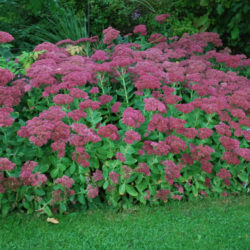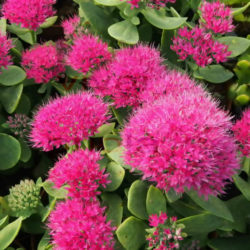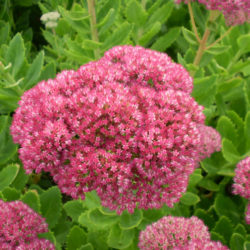Scientific Name
Hylotelephium spectabile 'Brilliant'
Common Name(s)
Brilliant Stonecrop, Showy Stonecrop, Upright Sedum
Synonym(s)
Hylotelephium 'Brilliant', Sedum spectabile 'Brilliant', Sedum 'Brilliant'
Scientific Classification
Family: Crassulaceae
Subfamily: Sempervivoideae
Tribe: Telephieae
Genus: Hylotelephium
Description
Hylotelephium spectabile 'Brilliant', formerly known as Sedum spectabile 'Brilliant', is a succulent plant that forms clumps of upright to slightly spreading stems with egg-shaped, grayish-green leaves with toothed margins. The stems can grow up to 18 inches (45 cm) long.
The tiny star-shaped flowers are dark pink and appear in large, flat-topped heads atop the stems. The flower heads are up to 6 inches (15 cm) in diameter.
Origin
Hylotelephium spectabile 'Brilliant' is one of the original deep pink selections (Brilliant Group) of Hylotelephium spectabile, but it tends to revert, and its true identity is rather obscure. It originated in the United States before 1913.

Hardiness
USDA hardiness zones 3a to 9b: from −40 °F (−40 °C) to 30 °F (−1.1 °C).
How to Grow and Care
These popular garden plants are easy to grow. Hylotelephiums are ideal for that part of your garden that gets too much sun or too little water to grow anything else. They also grow well in containers.
Hylotelephiums prefer full sun. They tolerate light to partial shade in hot summer climates but produce weak, floppy growth when grown in too much shade or overly rich soils.
These succulents do not need rich soil, but they do need excellent drainage. Choose a commercial potting mix for succulents, or make one yourself.
Hylotelephiums are drought-tolerant once established. The best way to water a Hylotelephium is to use the "soak and dry" method. First, get the soil completely wet, then wait until it is dry before watering again.
Feed annually with a balanced fertilizer. According to package directions, apply the fertilizer to the soil in spring as new growth appears.
Hylotelephiums can be grown from seeds, division, or stem cuttings.
Learn more at How to Grow and Care for Hylotelephium.
Links
- Back to genus Hylotelephium
- Succupedia: Browse succulents by Scientific Name, Common Name, Genus, Family, USDA Hardiness Zone, Origin, or cacti by Genus
Photo Gallery
Click on a photo to see a larger version.



